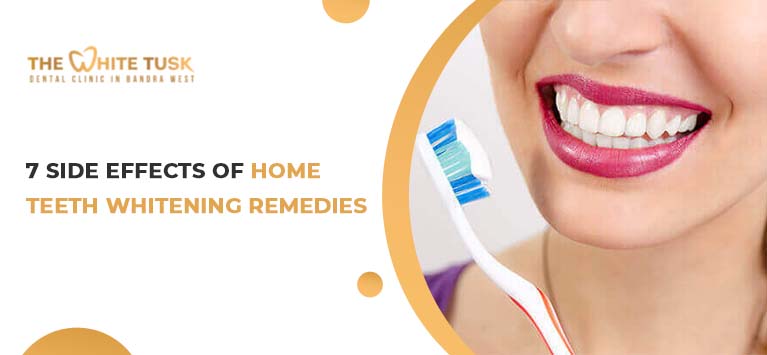
7 Side Effects of Home Teeth Whitening Remedies
Many people use home remedies for teeth whitening because they’re natural, inexpensive, and easy to try. Common home remedies include using baking soda, hydrogen peroxide, or fruit peels. People believe these methods can help remove stains and make their teeth look whiter and it does with proper guidance
However, it’s important to be cautious and not use these remedies too often, as they might not be as effective as professional treatments and could potentially harm the teeth or gums if used improperly.
Some of the home teeth whitening methods are
OIL PULLING
Oil pulling is a natural remedy where you swish oil, like coconut or sesame oil, in your mouth for a few minutes to help clean your teeth and gums. But some of the possible side effects of oil pulling are.
- DRY MOUTH: The oil could absorb saliva and leave your mouth feeling dry.
- UPSET STOMACH: If you accidentally swallow the oil, it might bother your stomach.
- DISCOMFORT: Swishing oil might not feel great, especially if you’re not used to it.
BRUSHING WITH BAKING POWDER
Baking powder’s gritty texture gently scrubs away surface stains from teeth when brushed, helping to make them look cleaner and brighter. Some of the side effects of using baking powder are
- TOOTH SENSITIVITY: Baking powder might make your teeth sensitive to hot or cold things.
- GUM IRRITATION: It could irritate your gums if you brush too hard.
- ENAMEL WEAR: Brushing too vigorously or often might wear down the protective layer on your teeth.
USING ROCK SALT
People use rock salt for teeth whitening because they think it’s gentle scrubbing action might help remove stains
- ENAMEL DAMAGE: Scrubbing too hard with rock salt might harm the protective layer on your teeth.
- GUM IRRITATION: Rubbing rock salt on teeth might irritate your gums and make them sore.
- TOOTH SENSITIVITY: Rock salt could make your teeth sensitive to hot or cold things.
WHITENING WITH FRUIT
Whitening teeth with fruit works due to natural acids in fruits like strawberries, which can lift surface stains. Yet, it’s milder than pro methods
- SUGAR CONTENT: Some fruits are sugary and could contribute to tooth decay if not rinsed well.
- TOOTH SENSITIVITY: Fruit acids can make teeth sensitive to hot or cold things.
- ENAMEL WEAR: Excessive rubbing could harm the protective layer on teeth
USING HYDROGEN PEROXIDE
Hydrogen peroxide whitens teeth by breaking down and removing surface stains on the enamel through a chemical oxidation process but leads to the following side effects if used improperly.
- TOOTH SENSITIVITY: Hydrogen peroxide can penetrate the enamel and reach the dentin layer of your teeth, where the nerve endings are located. This can increase tooth sensitivity, causing discomfort when consuming hot, cold, or sweet foods and beverages.
- GUM IRRITATION: Hydrogen peroxide is a powerful chemical, and if it comes into contact with your gums, it can cause irritation and inflammation. This may result in redness, soreness, or even bleeding of the gums.
USING ACTIVATED CHARCOAL
Due to their abrasiveness, activated charcoal can effectively eliminate specific stains from the enamel, the outermost layer of teeth
- RESPIRATORY RISK: Using powdered charcoal can pose inhalation risks, leading to potential respiratory irritation if the fine particles are inhaled.
- GUM IRRITATION: Scrubbing charcoal on teeth might cause gum irritation and inflammation if the abrasive particles come into contact with the gums.
- STAINING: Charcoal particles can become embedded in cracks and crevices of teeth, causing a gray or black appearance
USING DAIRY PRODUCTS
Chewing cheese is helpful to whiten your teeth and using additional dairy products like yogurt, cheese also works because they contain minerals like calcium and phosphates which can brighten your teeth and reduce the appearance of stains
- ALLERGIES: If you’re allergic to dairy, using these products might cause reactions.
- MOUTH SENSITIVITY: Dairy’s acidity might make your teeth sensitive if used excessively.
- SUGAR CONTENT: Some dairy products contain sugar, which could lead to tooth decay if not cleaned properly
ALTERNATIVE DENTAL TREATMENTS
Professional teeth whitening is crucial since it was done by dental experts, who ensure safe and effective outcomes. Their stronger whitening agents and careful supervision minimize risks, providing longer-lasting whitening outcomes compared to home methods
The following steps involve in a professional teeth whitening treatment
- INITIAL ASSESSMENT: The dentist begins by recording your current tooth shade.
- SURFACE POLISHING: Teeth are polished using pumice to remove surface plaque.
- ISOLATION AND PROTECTION: Gauze and retractors keep the mouth and gums dry and shielded from the whitening solution.
- GUM LINE PROTECTION: A barrier safeguards the gumline from solution exposure.
- SOLUTION APPLICATION: A front-surface whitening solution containing hydrogen peroxide or carbamide peroxide is applied and activated, often with light.
- TREATMENT AND FOLLOW-UPS: After 30-60 minutes, teeth are rinsed; fluoride may ease sensitivity. Additional visits are scheduled until the desired shade is achieved
CONCLUSION
Teeth whitening methods may seem appealing but they too have potential risks such as enamel damage, gum irritation, and tooth sensitivity, whereas professional teeth whitening administered by dental experts, offers a safer and more effective alternative. If you have any further questions or would like to learn more, please don’t hesitate to reach out to us
